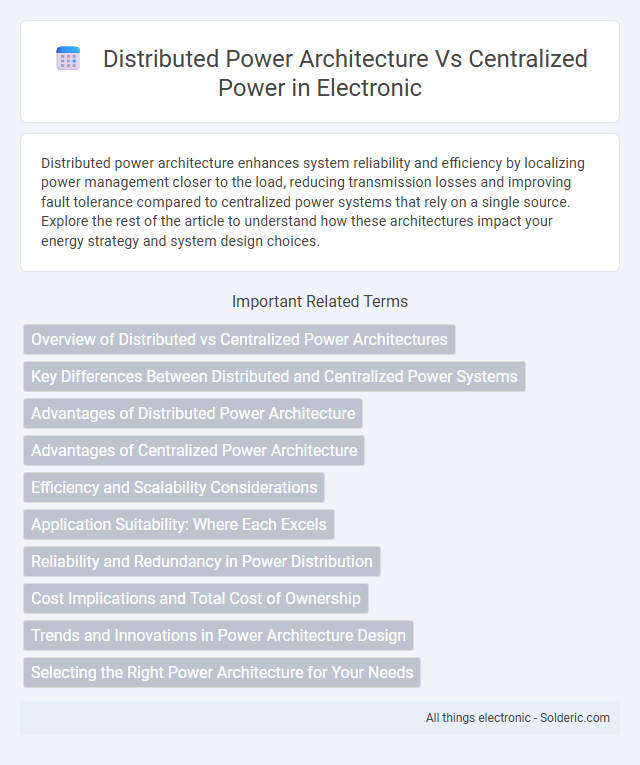Distributed power architecture enhances system reliability and efficiency by localizing power management closer to the load, reducing transmission losses and improving fault tolerance compared to centralized power systems that rely on a single source. Explore the rest of the article to understand how these architectures impact your energy strategy and system design choices.
Comparison Table
| Feature | Distributed Power Architecture (DPA) | Centralized Power Architecture (CPA) |
|---|---|---|
| Power Delivery | Multiple localized power modules close to loads | Single central power supply providing power to all components |
| Efficiency | Higher, due to reduced transmission losses and improved voltage regulation | Lower, potential for higher losses over long distances |
| Scalability | Highly scalable; easy to add or modify modules | Limited scalability; redesign often needed for expansion |
| Complexity | Higher system complexity with multiple power modules | Simpler design with centralized control |
| Reliability | Improved fault tolerance; failure localized to modules | Single point of failure risk; system-wide outages possible |
| Thermal Management | Distributed heat sources; easier localized cooling | Concentrated heat generation; requires robust cooling |
| Cost | Higher initial investment; cost-effective at scale | Lower upfront cost; potential higher maintenance costs |
| Applications | Data centers, telecommunications, automotive electronics | Traditional computing systems, legacy power supplies |
Overview of Distributed vs Centralized Power Architectures
Distributed power architecture divides power sources across multiple points within a system, enhancing efficiency, scalability, and fault tolerance. Centralized power architecture relies on a single power source or hub, simplifying management but risking complete failure if the central unit malfunctions. Your choice depends on system complexity, reliability requirements, and energy management goals.
Key Differences Between Distributed and Centralized Power Systems
Distributed power systems feature multiple small-scale generation units located near load centers, reducing transmission losses and enhancing system reliability. Centralized power systems rely on large, centralized plants that generate electricity transmitted over long distances, which can lead to higher transmission costs and vulnerability to single points of failure. Distributed architecture supports grid flexibility and integration of renewable energy sources, while centralized systems offer economies of scale but limited adaptability to dynamic energy demands.
Advantages of Distributed Power Architecture
Distributed Power Architecture (DPA) improves system efficiency by reducing power loss through localized voltage regulation near the load, enhancing overall energy management. This architecture offers superior scalability and flexibility, enabling easier integration of diverse power sources and adapting to varying demand without significant redesign. DPA also enhances reliability and fault tolerance by isolating failures to localized zones, minimizing impact on the entire system and improving maintenance efficiency.
Advantages of Centralized Power Architecture
Centralized Power Architecture (CPA) offers simplified system design by consolidating power management into a single unit, improving efficiency and reducing overall component count. This architecture enhances thermal management and reliability through concentrated monitoring and control, facilitating easier maintenance and troubleshooting. Centralized power systems also provide cost savings in large-scale applications due to optimized power distribution and uniform voltage regulation across multiple modules.
Efficiency and Scalability Considerations
Distributed power architecture enhances efficiency by minimizing power loss through localized energy conversion and reducing transmission distances, resulting in improved overall system performance. Scalability is superior in distributed systems due to modular design, which allows incremental expansion and adapts seamlessly to varying load demands. Centralized power systems often face challenges with scalability and efficiency as power transmission over long distances causes significant energy losses and limits flexible capacity upgrades.
Application Suitability: Where Each Excels
Distributed power architecture excels in complex systems requiring scalability and enhanced fault tolerance, such as automotive electric vehicles and renewable energy grids. Centralized power systems are more suitable for applications with stable, predictable loads like traditional industrial plants and data centers, where efficiency and simplified management are priorities. Your choice depends on factors like system size, reliability needs, and flexibility for future expansion.
Reliability and Redundancy in Power Distribution
Distributed power architecture enhances reliability by localizing power generation closer to critical loads, minimizing the impact of single-point failures common in centralized power systems. Redundancy is inherently built into distributed systems through multiple, independent power sources that quickly compensate for outages, ensuring continuous operation. Your operations benefit from increased fault tolerance and faster recovery times compared to traditional centralized power distribution.
Cost Implications and Total Cost of Ownership
Distributed power architecture often reduces installation and maintenance costs by localizing power conversion and minimizing power losses, leading to improved energy efficiency. Centralized power systems typically involve higher upfront capital expenditure for large-scale power conversion equipment and increased cooling requirements, raising total cost of ownership over time. Your choice between architectures significantly impacts operational expenses and long-term financial investment, with distributed systems often delivering more cost-effective and scalable energy solutions.
Trends and Innovations in Power Architecture Design
Distributed power architecture (DPA) is increasingly favored for enhancing efficiency, scalability, and thermal management in modern electronic systems, driven by trends such as AI acceleration and 5G infrastructure demands. Innovations include advanced DC-DC converters, dynamic voltage scaling, and intelligent power management chips that localize control and reduce power loss. Centralized power designs are evolving with modular architectures and improved regulation techniques, but DPA's adaptability to heterogeneous workloads and energy harvesting is setting new standards in power architecture design.
Selecting the Right Power Architecture for Your Needs
Selecting the right power architecture for your needs depends on factors like system complexity, efficiency, and scalability. Distributed power architecture offers enhanced modularity and improved thermal management by placing multiple regulators closer to the load, reducing power losses and enabling more precise voltage control. Centralized power architecture simplifies design and maintenance but may struggle with efficiency and heat dissipation in larger systems.
distributed power architecture vs centralized power Infographic

 solderic.com
solderic.com